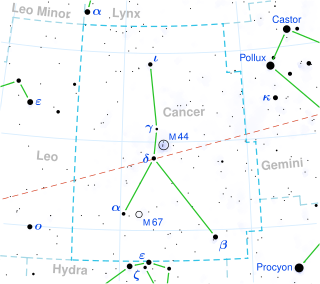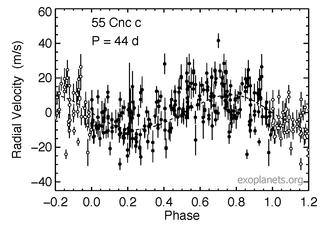In quantum mechanics, bra–ket notation is a standard notation for describing quantum states. It can also be used to denote abstract vectors and linear functionals in mathematics. The notation uses angle brackets and a vertical bar, to denote the scalar product of vectors or the action of a linear functional on a vector in a complex vector space.
The scalar product or action is written as

Cancer is one of the twelve constellations of the zodiac. Its name is Latin for crab and it is commonly represented as one. Its astrological symbol is . Cancer is a medium-size constellation with an area of 506 square degrees and its stars are rather faint, its brightest star Beta Cancri having an apparent magnitude of 3.5. It contains two stars with known planets, including 55 Cancri, which has five: one super-earth and four gas giants, one of which is in the habitable zone and as such has expected temperatures similar to Earth. Located at the center of the constellation is Praesepe, one of the closest open clusters to Earth and a popular target for amateur astronomers.

55 Cancri is a binary star system located 41 light-years away from the Sun in the zodiac constellation of Cancer. It has the Bayer designation Rho1 Cancri (ρ1 Cancri); 55 Cancri is the Flamsteed designation. The system consists of a G-type star and a smaller red dwarf.

Alpha Cancri, also named Acubens, is a star system in the constellation of Cancer.

Beta Cancri, also named Tarf, is the brightest star in the zodiacal constellation of Cancer. It has an apparent visual magnitude of +3.5 and an absolute magnitude of −1.2. Based on parallax measurements obtained during the Hipparcos mission, it is approximately 290 light-years distant from the Sun. An exoplanet, designated Beta Cancri b, is believed to be orbiting the star.
Gamma Cancri is a multiple star system in the constellation of Cancer.

Delta Cancri is a double star about 180 light-years from the Sun in the constellation of Cancer.
Zeta Cancri is a multiple star system in the constellation of Cancer. It is approximately 83.4 light-years from Earth, and has a combined apparent magnitude of +4.67. Since it is near the ecliptic, it can be occulted by the Moon and, very rarely, by planets.
Eta Cancri, Latinized from η Cancri, is a single, orange-hued star in the zodiac constellation of Cancer. It is a faint star but visible to the naked eye with an apparent visual magnitude of 5.34. The annual parallax shift of 10.93 mas as seen from Earth yields a distance estimate of 155 light years from the Sun. It is moving further away with a radial velocity of +22 km/s.
Lambda Cancri is a blue-white hued spectroscopic binary star in the zodiac constellation of Cancer. With a combined apparent visual magnitude of +5.93, it is faintly visible to the naked eye. Based upon parallax measurements obtained during the Gaia mission, it is about 550 light-years distant from the Sun.
Xi Cancri is a spectroscopic binary star system in the zodiac constellation of Cancer. It is visible to the naked eye with an apparent visual magnitude of +5.15. Based upon parallax measurements obtained during the Hipparcos mission, it is roughly 370 light-years distant from the Sun.
14 Cancri is a star in the northern zodiac constellation of Cancer. It can be referred to as ψ Cancri, very occasionally as ψ2 Cancri, to distinguish it from 13 Cancri which is sometimes called ψ1 Cancri. It is just barely visible to the naked eye, having an apparent visual magnitude of +5.73. Based upon an annual parallax shift of 24.18 mas as seen from Earth, it is located 135 light years from the Sun. It may be a member of the Wolf 630 moving group of stars.
13 Cancri is a K-type giant star in the constellation Cancer. It has an apparent magnitude of +6.44 and is approximately 1030 light years from Earth.
42 Cancri is a star in the constellation Cancer. Its apparent magnitude is 6.83.

55 Cancri e is an exoplanet in the orbit of its Sun-like host star 55 Cancri A. The mass of the exoplanet is about 8.63 Earth masses and its diameter is about twice that of the Earth, thus classifying it as the first super-Earth discovered around a main sequence star, predating Gliese 876 d by a year. It takes less than 18 hours to complete an orbit and is the innermost known planet in its planetary system. 55 Cancri e was discovered on 30 August 2004. However, until the 2010 observations and recalculations, this planet had been thought to take about 2.8 days to orbit the star. In October 2012, it was announced that 55 Cancri e could be a carbon planet.

55 Cancri b, occasionally designated 55 Cancri Ab, also named Galileo, is an exoplanet orbiting the Sun-like star 55 Cancri A every 14.65 days. It is the second planet in order of distance from its star, and is an example of a hot Jupiter, or possibly rather "warm Jupiter".

55 Cancri c, formally named Brahe, is an extrasolar planet in an eccentric orbit around the Sun-like star 55 Cancri A, making one revolution every 44.34 days. It is the third known planet in order of distance from its star. 55 Cancri c was discovered on June 13, 2002 and has a mass roughly half of Saturn.

55 Cancri d, formally named Lipperhey, is an extrasolar planet in a long-period orbit around the Sun-like star 55 Cancri A. Located at a similar distance from its star as Jupiter is from our Sun, it is the fifth and outermost known planet in its planetary system. 55 Cancri d was discovered on June 13, 2002.

55 Cancri f, also designated Rho1 Cancri f and formally named Harriot, is an extrasolar planet approximately 41 light-years away from Earth in the constellation of Cancer. 55 Cancri f is the fourth known planet from the star 55 Cancri and the first planet to have been given the designation of "f".
44 Cancri is an orange-to-red star located in the constellation Cancer. It has an apparent magnitude of 8.04 and its radius is about 12.11 R☉.









